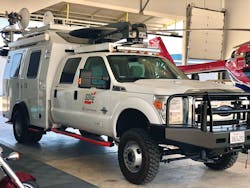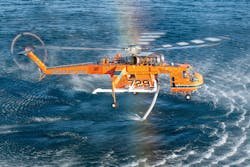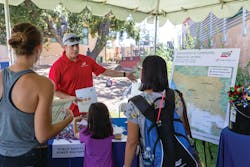In the era being branded as the new normal, where climate change is an everyday challenge, new ways of thinking coupled with new technologies must be developed to keep pace with the changing environment. Ensuring the safety of nearly 3.6 million San Diegans who rely on San Diego Gas & Electric (SDGE) to power their daily lives, especially in today’s climate, means the utility cannot afford to ignore operational and engineering advancements, situational awareness and community engagement. Rather, it makes system hardening, vegetation management and community outreach a top priority.
In October 2007, the U.S. San Diego region experienced unprecedented levels of destruction from firestorms. At the time, the fires were ranked among the most destructive in California’s history. They were a game changer for the utility, as the flames destroyed 1,738 homes and consumed more than 368,316 acres (149,052 hectares). "Never again" became the rallying cry across the organization — not just for operations, but for everyone, from the frontline employees to the CEO. This rallying cry was transformative because it became a bottom-up mechanism for change. Employees at all levels were empowered to provide insights on how to engineer and operate the system and help to protect the communities the utility serves. The rallying cry became personal for everyone at SDG&E.
As part of the utility’s vision and ongoing effort to help reduce fires in the county’s high-fire risk areas, the SDG&E community started thinking about how best to design, engineer, construct and maintain the utility’s infrastructure against the threat of increasingly violent fires. Since 2007, SDG&E has rolled out numerous innovative programs centered on building situational awareness, fire hardening its infrastructure and putting protocols in place on how to operate when there is a fire risk. Some of the programs included upgrading more than 18,000 poles from wood to steel; enhancing the vegetation management plan in place where 460,000 trees are trimmed and evaluated annually by a team of highly trained arborists; designing a complimentary new tool, the Vegetation Risk Index, for operational and emergency decision-making; forming a new Wildfire Safety Community Advisory Council; and, most recently, building a Fire Science and Innovation Lab, scheduled to open later in 2020.
Situational Awareness
In 2007, the climate change discussion was not nearly what it is today. But, one thing was clear: Californians were experiencing climate conditions they had not experienced in previous decades. SDG&E’s decision to innovate paved the way for bolder decisions to be made. The utility knew it had a responsibility to its customers — and its employees — to operate a safe and reliable system.
The conscious decision was made to invest in a meteorology team, a sophisticated weather monitoring network and mountaintop cameras to help monitor fires in real time. This investment enhanced the collective situational awareness of SDG&E, which the utility shares with first responders.
Over the course of 10 years, the utility developed weather technology to detect, monitor, and forecast weather conditions and fire behavior. Today, the amount of data collected and time in which it is retrieved has improved significantly because of SDG&E’s use of artificial intelligence (AI), satellite wildfire alerts.
SDG&E’s network of more than 190 weather stations is the world’s first utility network of its kind, capable of providing reads on temperature, humidity and wind every 30 seconds, instead of every 10 minutes. It drives the utility to make more precise, data-driven decisions to keep its communities safe. The data then is shared with more than 50 fire agencies that serve the region.
The use of satellites is another groundbreaking undertaking of SDG&E and a way to track wildfire activity from space. Satellites enable the utility to identify wildfire locations accurately and help to increase the safety of electric infrastructure.
AI-based predictive models increase the accuracy of weather forecasts, which in turn helps to prevent power line ignitions and enhances SDG&E’s capability to plan and execute public safety power shutoffs (PSPS) strategically. Today, the utility leverages fire behavior modeling and supercomputers to run 10 million fire simulations daily, so it knows precisely which areas face the most potential for catastrophic wildfires given the weather conditions forecasted.
SDG&E serves a region that encompasses 4,100 sq miles (10,619 sq km), spread over 25 cities and two counties. With responsibility for such an expansive area, personnel often are asked how they keep tabs on the state of vegetation. The answer: with a little bit of help from AI and outer space.
AI also is used for vegetation management to help digest the large amounts of data the utility retrieves on the 460,000 trees that the company maintains. Multiply that number by nearly 10 years of data collection, and there are hundreds of millions of data points that can be analyzed by the utility’s team of arborists to yield intelligence and strategic action plans.
This pinpoint accuracy enables arborists and foresters to trim trees that grow near and around power lines according to species, typical growth rate and industry requirements. Staying ahead of a tree’s growth spurt by using historical weather data, such as the direction and severity of the wind as well as rainfall in a particular area, is an invaluable advantage.
About 243,000 of the 460,000 inventoried trees that are in the highest fire threat areas are assessed a second time each year by a certified arborist prior to the start of the traditional fire season in the fall to ensure safety and compliance. All trees requiring attention are then pruned or removed by professionally trained crews.
Last year, SDG&E’s meteorology and vegetation management teams collaborated to create a new tool, the Vegetation Risk Index (VRI). The VRI enables the company to identify high-risk areas based on advanced analytics of historical tree-caused outages, meteorological data and tree species profiles. The index is designed to support operational and emergency decision-making. Decision makers consider the VRI for each circuit before deciding whether to turn off power to an area during a dangerous fire weather.
To prepare SDG&E’s daily Fire Potential Index (FPI), the risk of wildfires in the utility’s eight-operating districts are categorized in three levels: normal, elevated and extreme. The meteorology team leverages data from NASA’s MODIS satellites as well as from the National Oceanic and Atmospheric Administration’s (NOAA’s) geostationary satellite. These data sources feed into the forecasting system in the weather center.
The meteorologists also monitor 17 high-definition, livestream mountaintop cameras as well as help field crews to pre-stage staffing and resources ahead of extreme weather and fire conditions. They developed outage prediction and fire science modeling to do this work.
Fire Hardening
Building situational awareness through technological innovations is only one piece of the puzzle. Another piece is fire hardening the infrastructure, while simultaneously adopting new protocols on how to operate before, during and after fire season as well as on days when the FPI shows extreme risk.
Back in 2007, the SDG&E’s poles were designed to withstand 56-mph (90-kmph) winds, as required by the California Public Utilities Commission. Through its meteorological data, the utility learned there are areas in the San Diego backcountry that experience greater than 100-mph (161-kmph) wind gusts. As a result, the utility began hardening its infrastructure in those areas.
Over the past decade, SDG&E has hardened 400 miles (644 km) of its transmission system in its high fire threat district (HFTD) by replacing wood poles with more durable and weather-resistant steel poles as well as upgrading to larger conductor and larger spacing between the conductors. Today’s design standard is 85 mph (137 kmph), with 111 mph (179 kmph) for areas with the highest fire risk, in compliance with the National Electrical Safety Code Rule 250C.
To complement fire-hardening efforts, SDG&E also adopted new safety protocols for operating the power grid during adverse fire danger conditions. When the FPI is elevated, all power line reclosing switches are turned off and remain off until the FPI returns to normal for an extended duration. Reclosers are turned off in the areas most prone to wildfire to prevent electrical devices from automatically reenergizing lines that have detected a fault.
The strategic installations of multiple sectionalizing switches on a circuit also enables the utility to act with greater precision and limit the number of customers impacted by PSPS.
SDG&E’s investments in the installation of these devices are paying off. For example, a few years ago, turning off a circuit segment may have impacted 1000 or more customers. With these system enhancements, the utility now impacts an average of 500 customers per segment and, in some cases, as few as four.
Community Outreach
The third and last major piece of the puzzle is communicating and collaborating with the community. As one can imagine, shutting off power during adverse fire weather conditions is not the most popular move. SDG&E was initially met with opposition from members of the public, media, some elected officials and other impacted stakeholders when it first introduced deenergization as a wildfire safety mitigation strategy in 2008. SDG&E was the first utility to do this and some questioned why it had to turn off power for public safety.
Despite the harsh criticism, the utility did not deviate from this strategy. It held town hall meetings to communicate directly with residents in impacted areas, and personnel worked hard to build credibility and trust with the communities the utility serves and with its partners.
Today, in addition to town halls, community members attend wildfire mitigation and resiliency fairs. The fairs enable members of the community to engage with SDG&E employees, including the meteorology and vegetation management teams. They can ask questions about PSPS and emergency preparedness, as well as get a better understanding of what the utility is doing to keep the community safe. Attendees also receive emergency kit backpacks, information about developing emergency plans, and tips on how to design and modify the space around their home to help resist wildfire.
In September 2019, SDG&E formed a 10-member Wildfire Safety Community Advisory Council to bring together a group of diverse local leaders from public safety, tribal government, business, nonprofit, and academic organizations to provide feedback and recommendations on how the utility can continue to help protect the region from wildfires.
Another way SDG&E directly engaged with the community was through its 2019 generator grant program (GGP) pilot, in which portable renewable-powered battery units were provided to 64 medical baseline registered customers.
SDG&E recognizes PSPS events cause a great deal of inconvenience and, when factoring in those customers with medical conditions or who are not as mobile as other customers, the utility wanted to pilot a program that would help to support those customers.
The intention of this pilot is to help the most vulnerable populations, who are a part of the access and functional needs (AFN) community, become more resilient during PSPS events. GGP provides the renewable solar-powered battery as an additional tool in a customer’s emergency preparedness toolkit.
From Sky to Ground
In 2018, SDG&E added a second aerial firefighting asset, the Black Hawk. This was in addition to the contracted Erickson S64E Air Crane, the largest water-dropping helitanker in the U.S. The air crane can drop 2,650 gal (10,031 L) of water or fire suppressant, equivalent to what five fire engines can carry. The Black Hawk flies up to 140 mph (225 kmph) with a tank of water or fire suppressant while en route to a fire. It holds 850 gal (3218 L) and refills in 45 seconds.
Both helicopters are available to fire agencies in San Diego and South Orange counties 365 days a year. So far, the air crane is the only one with its own Twitter account, @SkyMaverickSDGE.
Additional assets in the sky are drones sent up to inspect SDG&E’s overhead electric distribution lines and poles located in the highest fire risk threat areas. The drones are part of the new drone investigation, assessment and repair (DIAR) program developed in August 2019.
Historically, SDG&E’s electric infrastructure has been inspected by ground crews and helicopters. The use of drones enhances this process in many ways. Fire-prone communities tend to be in hard-to-reach areas that require treacherous hiking and the use of helicopters. Because drones can fly close to the power lines and equipment, they enable crews to get a much closer look to assess and document conditions. If damage is found, crews prioritize repairs in those areas.
Moving from the sky to the ground, the tactical command vehicle (TCV) is SDG&E’s newest member of the team. The high-clearance, off-pavement vehicle can be set in motion when every minute counts. It can be deployed into the heart of challenging environments affected by wildfires and is vital to SDG&E’s safety efforts, as it enables faster deployment and quickly establishes full internet and satellite phone communications at temporary locations. Mobile connectivity also includes a touch-screen tabletop that enables responders to bring up maps of the region and critical energy infrastructure quickly as well as downlink helicopter video footage.
Manned by SDG&E employees, the unit can be made available to help support on-scene fire command staff, if requested. Using the sophisticated communication technology, key decision makers have all the tools necessary to make safe and informed decisions.
From Tragedy to Action
Today, SDG&E’s level of awareness and preparation is drastically different than on that first day in 2007 when the National Weather Service declared a red-flag warning.
This ongoing process, and having to contend with wildfires, forces SDG&E to self evaluate and reflect: What is the utility not looking at that it should be, and what are the opportunities for change that it has not thought about before?
Throughout SDG&E’s journey so far, team members have learned they must have alignment from all levels of the organization, they need to focus on customer safety and they cannot do it alone. So, while SDG&E has a process in place that has enhanced public safety, the utility is not stopping there. It knows there is a need for ever-evolving advancement, innovation and communication to protect the region from the threat of wildfire today, tomorrow and in the future.
For more information:
Erickson | https://ericksoninc.com
About the Author
Brian D’Agostino
Brian D’Agostino is the director of fire science and climate adaptation for San Diego Gas & Electric (SDG&E). As director, D’Agostino is responsible for meteorology, fire science, the Community Fire Safety Program, and climate adaptation initiatives. D’Agostino joined the SDG&E in 2009 and oversaw the development of the SDG&E’s weather network, one of the nation’s largest and most sophisticated weather networks. D’Agostino serves as an advisor and former chair of the American Meteorological Society’s National Energy Committee and sits on several advisory committees specializing in climate adaptation and fire science. D’Agostino is a graduate of Plymouth State University with a bachelor of science in meteorology.





